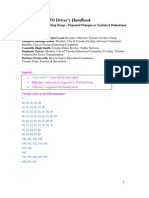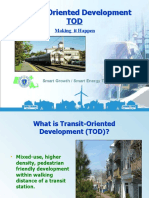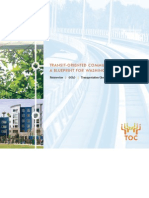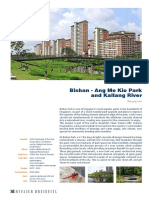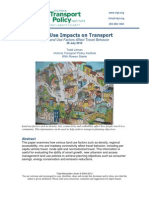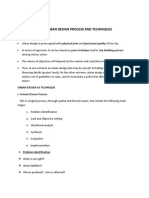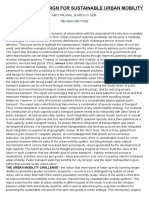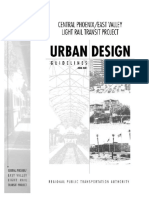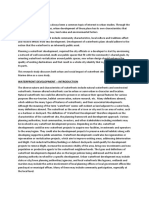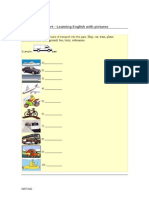Professional Documents
Culture Documents
History of Transit-Oriented Development (Tod)
History of Transit-Oriented Development (Tod)
Uploaded by
AirBlackmanOriginal Description:
Original Title
Copyright
Available Formats
Share this document
Did you find this document useful?
Is this content inappropriate?
Report this DocumentCopyright:
Available Formats
History of Transit-Oriented Development (Tod)
History of Transit-Oriented Development (Tod)
Uploaded by
AirBlackmanCopyright:
Available Formats
Appendix B: History of Transit-Oriented Development
HISTORY OF TRANSIT-ORIENTED DEVELOPMENT (TOD)
A. DEFINITION OF TRANSIT-ORIENTED DEVELOPMENT
Much has been written about transit-oriented development (TOD) in recent years, and a number of research efforts have provided
detailed evaluations of successful TOD projects in such diverse locations as the San Francisco Bay Area, Washington D.C.,
Atlanta, and San Diego. Throughout the literature, TOD projects are referred to by a variety of names, including transit-focused
development, transit-based development, transit-supportive development, or transit villages. As with names, the definition of TOD
varies somewhat depending upon the researcher. According to Bernick and Cervero, who prefer the term transit village, TOD
consists of a compact, mixed-use community, centered around a transit station that, by design, invites residents, workers, and
shoppers to drive their cars less and ride mass transit more.1 Lefaver describes TOD somewhat broadly as higher density,
residential or mixed-use developments built along transportation corridors. . .i.e., rail and major bus lines as well as freeways.2
Porter limits TOD to development generally within a half a mile of rail transit stations.3 This project focuses on TOD near rail or
light rail stations.
B. BRIEF HISTORY OF TRANSIT-ORIENTED DEVELOPMENT
The first transit-oriented development projects in the United States were the railroad and streetcar suburbs of the late 19th and early
20th centuries. The earliest commuter rail lines were powered by steam engines that could achieve high sustained speeds efficiently
Michael Bernick and Robert Cervero, Transit Villages in the 21st Century (New York: McGraw Hill, 1997), p. 5.
Scott Lefaver, Private Land with Public Partnerships for Transit Based Development (San Jose, CA: Norman Y. Mineta International Institute for Surface Transportation
Policy Studies, 1997), p. 2.
Douglas Porter, Transit-Focused Development (Washington, D.C.: National Academy Press, 1997), p. 1.
_______________________________
Mineta Transportation Institute
Appendix B: History of Transit-Oriented Development
but were slow to accelerate and decelerate, and thus promoted the development of stations that were several miles apart.4 In New
York City, for example, three commuter railroads the Hudson River Railroad, Harlem River Valley Railroad, and Long Island
Sound Railroad helped channel population expansion from the five boroughs to outlying suburban townships.5 Although more
common in large east coast cities, a steam-powered commuter rail service did exist in the San Francisco Bay Area in the late 19th
century. The San Francisco-San Jose railway began service along the Peninsula in 1864, and led to the development of commuter
suburbs such as Burlingame, Redwood City, and San Mateo.6 Today CalTrain follows this corridor.
Electric street railways were developed in the late 1880s. Electric streetcars picked up their power from an overhead electrical line
(using a trolley pole), and used the running rail as a ground.7 Although electric streetcars could not achieve the top speeds of the
steam engines, they were cleaner, quieter, and could start and stop more efficiently, making them useful for interurban as well as
commuter service. Construction of electric railway systems was typically privately funded, as developers built rail lines to outlying
areas and used the railways to promote their real estate holdings. The first electric streetcar system was the Pacific Electric
Railway in southern California which, at its peak, served 50 communities with 1,164 miles of track and 270 trains a day. 8 In the
San Francisco Bay Area, the San Francisco, Oakland & San Jose Railway, more commonly known as the Key System, had
developed a vast network of lines in the East Bay by the turn of the century. The extension of Key System lines into previously
undeveloped areas of the Berkeley-Oakland Hills led to the rapid settlement of new townships such as Piedmont.9
Steve Colman, San Jose State University, URBP 226 Course Reader, Fall 1999 (San Jose State University Department of Urban and Regional Planning), p. 3-4.
Bernick and Cervero, p. 16.
Colman, p. 2-4.
Ibid., p. 2-4
Bernick and Cervero, p. 20.
Ibid., p. 24
____________________________________
Mineta Transportation Institute
Appendix B: History of Transit-Oriented Development
By the early 1900s, electric streetcar systems had emerged in cities throughout the United States, replacing horse-drawn or cablepulled systems. According to Middleton, . . . more than any other development, the electric streetcars contributed to the growth of
Americas suburbs.10 Population growth followed car lines, as middle class households sought to escape crowded, dirty, and
noisy inner-city living. The success of the early streetcar suburbs was dependent on pedestrian access to transit for connection to
downtown jobs and neighborhood services. Typical features of these early transit neighborhoods included a transit depot and
public space in the center of the neighborhood, small cottage-type houses, and a street pattern and scale that allowed convenient
walking distances to transit.11
C. CHARACTERISTICS OF TRANSIT-ORIENTED DEVELOPMENT
1. Major Elements of TOD
Transit-oriented development projects should, at the very least, encourage the use of public transit by siting residential,
commercial, or office uses or a combination of all three close to a transit node. However, successful TOD involves more than
simply placing a transit stop in a residential neighborhood or business park, or building a mixed use TOD development next to a
transit hub . In addition to providing transportation options, transit-oriented development should improve the livability of
communities and neighborhoods, while successfully being integrated into the economic pattern of the area. TOD can create places
for community life, serve as a key force in the revitalization of neighborhoods and center cities, help create new businesses and
improve access to job opportunities, and help make communities safer, in part by making them more comfortable and attractive.12
According to Bernick and Cervero, the hallmarks of transit-oriented development are: 1) enhanced mobility and environment; 2)
10
W. Middleton, The Time of the Trolley (Milwaukee: Kalmback Publishing, 1967), p. 44.
11
Robert Cervero, Transit-Supportive Development in the U.S. (Washington, D.C.: Federal Transit Administration, 1993), p. 4.
12
Transit Cooperative Research Program, The Role of Transit in Creating Livable Metropolitan Communities (Washington, D.C.: National Academy Press, 1997), p. 20.
____________________________________
Mineta Transportation Institute
Appendix B: History of Transit-Oriented Development
pedestrian friendliness; 3) alternative suburban living and working environments; 4) neighborhood revitalization; 5) public safety;
and 6) public celebration.13 Table 1 discusses these elements in detail.
13
Bernick and Cervero, p. 7-11.
____________________________________
Mineta Transportation Institute
Appendix B: History of Transit-Oriented Development
Table 1: Major Elements of Transit-Oriented Development
Element
Description
Enhanced Mobility
and Environment.
The major element of TOD is a congregation of housing, jobs,
shops, and other activities around transit. In addition to the
improved access to these varied land uses, the physical
environment is enhanced. For example, TOD is expected to
result in improved air quality, as park-and-ride trips are
converted to walk- or bike-and-ride trips.
Pedestrian
Friendliness.
TOD involves the development of land uses that encourage
walking, such as narrow streets with trees, wide sidewalks, an
absence of surface parking lots and large building setbacks.
Typical structures are street-oriented, mixed use buildings that
include a blend of residential, retail, and commercial uses.
Alternative Suburban
Living
TOD allows an opportunity to live in the suburbs without being
entirely dependent on the automobile to access the variety of
activities and services associated with cities. The pedestrianfriendly scale and design features of transit-oriented
development promote social interaction.
Neighborhood
Revitalization.
TOD can be a means of stimulating economic growth in blighted
or declining areas served by rail or other transit. Redevelopment
activities can promote transit-oriented development and improve
the social and physical infrastructure of neighborhoods,
providing needed housing and services to households from a mix
of incomes.
____________________________________
Mineta Transportation Institute
Appendix B: History of Transit-Oriented Development
Public Safety.
TOD places a mix of residents, workers, and shopkeepers within
a compact area, allowing for a continual security presence by
virtue of the constant activity.
Public Celebration.
TOD should include some public open space, such as a plaza or
park, that serves as a gathering place for events such as parades,
performances, concerts, or a farmers market.
Source: Based on Bernick and Cervero, Transit Villages, 1997
2. Relationship of TOD to New Urbanism and Smart Growth
In recent years, both New Urbanism and smart growth have emerged as buzzwords in the planning profession, and have even
gained some recognition in the mainstream media as progressive approaches to solving problems associated with suburban sprawl.
Both the New Urbanist and smart growth movements advocate some of the basic elements of transit-oriented development, so it is
useful to briefly discuss each here.
New Urbanism, also called neo-traditional planning, has been championed over the past two decades by urban designers and
architects such as Peter Katz, Andres Duany, Elizabeth Plater-Zyberk, Peter Calthorpe, and Daniel Solomon. These individuals and
other promoters of New Urbanism have even incorporated themselves into an architectural reform movement called the Congress
for the New Urbanism. 14 The New Urbanists generally advocate returning to pre-World War II town planning principles, with an
emphasis on designs that provide mixed land uses, narrow streets laid out in tight grid mesh, decreased setbacks, and reduced
parking, among others. Many of the types of design features that make TOD projects successful are the types of features that are
included in New Urbanist projects. However, transit is not a required feature of New Urbanist development. Many New Urbanist
14
James Howard Kunstler, Home From Nowhere (New York: Touchstone, 1996), p. 19.
____________________________________
Mineta Transportation Institute
Appendix B: History of Transit-Oriented Development
projects are taking place in suburban or exurban areas and while they may contain higher densities and more pedestrian friendly
design features they are not accessible via public transit.15 Some New Urbanist projects include transit stations; for example,
Peter Calthorpes Crossings project in Mountain View, California, is situated across from a stop on the CalTrain line.
Smart growth is a somewhat broader and more mainstream movement that draws on many of the principles of New Urbanism.
There is no single definition of smart growth, but the common thread is development that revitalizes central cities and older
suburbs, supports and enhances public transit, and preserves open spaces and agricultural lands.16 The underlying premise that
much of Americas post-World War II suburban development with its strict separation of land uses, low densities, and heavy auto
dependency has contributed to such problems as increased traffic congestion, loss of farmland, and the decline of traditional
downtown areas. Smart growth generally calls for higher-density, transit-oriented development, with an emphasis on providing a
balanced mix of housing, jobs, and shopping opportunities within a community. The Ahwahnee Principles, which are often cited
as the basic tenets of smart growth, contain many of the elements of successful transit-oriented development, including those listed
in Table 2. (It should be noted that the New Urbanist architects noted earlier were instrumental in convening the conference at
which the Ahwahnee Principles were drawn up.)
15
Timothy Beatley and Kristy Manning, The Ecology of Place (Covelo, CA: Island Press, 1997), p. 116.
16
Association of Bay Area Governments, Theory in Action, Smart Growth Case Studies (Oakland: ABAG, 2000), p. i.
____________________________________
Mineta Transportation Institute
Appendix B: History of Transit-Oriented Development
Table 2: Key Ahwahnee Principles that Relate to Transit-Oriented Development
Community size should be designed so that housing, jobs, daily needs and other
activities are within easy walking distance of each other.
As many activities as possible should be located within easy walking distance of
transit stops.
The location and character of the community should be consistent with a larger transit
network.
Streets, pedestrian paths and bike paths should contribute to a system of fullyconnected and interesting routes to all destinations. Their design should encourage
pedestrian and bicycle use by being small and spatially defined by buildings, trees
and lighting; and by discouraging high speed traffic.
The regional land-use planning structure should be integrated within a larger
transportation network built around transit rather than freeways.
Source: Local Government Commission, Center for Livable Communities website
____________________________________
Mineta Transportation Institute
Appendix B: History of Transit-Oriented Development
D. SPECIFIC FEATURES OF TRANSIT-ORIENTED DEVELOPMENT
1. Design Features
In general, transit-oriented development should promote walking and transit riding and discourage automobile use. A common
theme of TODs is to create places that have design features such as landscaped sidewalks, parking in the rear, and retail streetwalls
that make walking and transit riding more enjoyable. Some commonly-accepted TOD design features, as set forth by Bernick and
Cervero, are listed in Table 3, below.17 As mentioned above, many of these pedestrian- and transit-friendly features are embodied
in the designs of smart growth and New Urbanist projects.
17
Bernick and Cervero, p. 91-94.
____________________________________
Mineta Transportation Institute
Appendix B: History of Transit-Oriented Development
Table 3: Major Design Features of Transit-Oriented Development
Continuous and direct physical linkages between major activity centers; siting of
buildings and complementary uses to minimize distances to transit stops.
Streetwalls of ground-floor retail and varied building heights, textures, and facades
that enhance the walking experience; siting commercial buildings near the edge of
sidewalks.
Integration of major commercial centers with the transit facility.
Gridlike street patterns that allow many origins and destinations to be connected by
foot; avoiding cul-de-sacs, serpentine streets, and other curvilinear arrangements the
create circuitous walks and force buses to meander or retrace their paths; direct sight
lines to transit stops.
Minimizing off-street parking supplies; where land costs are high, tucking parking
under buildings or placing it in peripheral structures; in other cases, siting parking at
the rear of buildings instead of in front.
Providing such pedestrian amenities as attractive landscaping, continuous and paved
sidewalks, street furniture, urban art, screening of parking, building overhangs and
weather protection, and safe street crossings.
Convenient siting of transit shelters, benches, and route information.
Creating public open spaces and pedestrian plazas that are convenient to transit.
Source: Bernick and Cervero, Transit Villages , 1997
____________________________________
Mineta Transportation Institute
10
Appendix B: History of Transit-Oriented Development
2. Density Features
High density is another key element of transit-oriented development. If origins and destinations are spread throughout a region,
those with access to a car will likely drive rather than take transit.18 On the other hand, dense and compact TOD places a critical
mass of people in a single location, providing the ridership numbers necessary to make transit feasible and efficient. High density
offers three benefits to improved transit service: 1) routes to a relatively large number of points can be offered; 2) the cost per ride
of operating transit is reduced when ridership increases; and 3) increased density allows transit service to be provided more
frequently.19
A number of research efforts have shown a clear link between increased residential density and increased transit ridership. A
widely cited study conducted in 1977 by Pushkarev and Zupan concluded that sufficient rail transit demand requires residential
densities averaging 12 units per acre connected to a downtown with at least 50 million square feet of nonresidential uses. The
Pushkarev and Zupan study noted that residential densities in the 2 to 7 units per acre range produced only marginal transit use;
densities of between 7 and 30 units per acre were necessary to sustain significant transit use. With a density increase from 7 to 30
dwelling units, transit demand roughly tripled, and a sharp reduction in auto travel was noted.20 A 1984 study by Wilbur Smith
found a substantial increase in transit trips when residential densities increased from 7 to 16 units per acre.21 A 1994 study by
Holtzclaw confirmed that residential density is the major explanatory variable in vehicle miles traveled. Holtzclaw found that a
18
Ibid., p. 74.
19
Marya Morris, Creating Transit-Supportive Land Use Regulations (Chicago: American Planning Association, 1996), p. 41.
20
Boris S. Pushkarev and Jeffrey M. Zupan, Public Transportation and Land Use Policy (Bloomington: Indiana University Press, 1977), p. 30.
21
Wilbur Smith, Mass Transit for High-Rise, High-Density Living, Journal of Transportation Engineering 110(6), 1984.
____________________________________
Mineta Transportation Institute
11
Appendix B: History of Transit-Oriented Development
doubling of residential densities resulted in greater transit usage and a 20 to 30 percent reduction in annual household vehicle miles
traveled (VMTs).22
In general, the population and employment densities needed to support transit are significantly higher than the average densities in
most U.S. suburbs.23 Typical suburban, single-family detached subdivision densities are between one and eight units per acre, with
townhouse (single-family attached) densities ranging from 8 to 12 units per acre.
Based on the results of the above and other studies, some jurisdictions have adopted minimum density thresholds to be used when
evaluating new transit systems or the extension of existing systems. For example, the Denver Rapid Transit District has prepared
the Suburban Mobility Design Manual, which spells out the relationship of residential density to transit service. According to the
manual, densities of seven units per acre can support transit every 30 minutes; 30 units per acre can support transit every 10
minutes; and 50 units per acre can support more bus trips than auto trips.24
When analyzing large areas the minimum residential densities for transit services can also be expressed in terms of population per
square mile. In a report published in 1996 by the Transit Cooperative Research Program, Parsons Brinckerhoff have
summarized the Pushkarev and Zupan data in terms of minimum residential densities for three levels of bus service (minimum,
intermediate, and frequent), as well as for light rail and rapid transit. Using the 1990 average of 2.7 persons per housing unit in
California, and 640 acres per square mile Table 4 presents these threshold density levels in terms of persons per square mile.
Elsewhere we present colored thematic population maps with increasing darker shades of green for the population densities below
22
John Holtzclaw, Using Residential Patterns and Transit to Decrease Auto Dependence and Costs (San Francisco: Natural Resources Defense Council, 1994).
23
Morris, p. 41.
24
Cervero, p. 50.
____________________________________
Mineta Transportation Institute
12
Appendix B: History of Transit-Oriented Development
the approximately 15,000 persons per square mile needed to sustain light rail transit, and increasingly darker shades of red to redbrown for areas with more than 15,000 persons per square mile.
Table 4: Minimum Residential Densities for Various Types of Transit Services
Transit Service Type a
Bus - Minimum Service
Bus - Intermediate Service
Bus - Frequent Service
Light Rail
Rapid Transit
DU/Acrea
4
7
15
9
12
Persons/Sq.
Mileb
6,912
12,096
25,920
15,552
20,736
Color on
Pop/Density Maps
1990-2020
Light green
Dark green
Darkest red-brown
Red
Red-brown
Pushkarev and Zupan, Public Transportation and Land Use Policy, 1977
Reproduced in Transit Cooperative Research Program, Report 16, Transit and Urban Form, Vol. 2,
Transportation Research Board, National Research Council,
National Academy Press, Washington, D.C. 1996
Persons per square mile transformation of Pushkarev and Zupan densities
uses 2.7 persons per housing unit average for California from 1990 US Census data
and 640 aces per square mile, resulting in a conversion factor of 1,728 from
dwelling units per acre to persons per square mile.
____________________________________
Mineta Transportation Institute
13
Appendix B: History of Transit-Oriented Development
3. Proximity to Stations
The majority of transit trips involve some degree of walking to access stops or stations, therefore proximity of residences to stations
is also an important feature of transit-oriented development. According to Bernick and Cervero, a central premise of transit
villages is to concentrate development within one-quarter mile walking distance of rail stations.25 This element is directly related
to density; clearly, TOD must place a sufficient number of people within a reasonable walking distance of transit if an increase in
ridership is going to occur.
Research by Untermann on the walking behavior of Americans shows that 2,300 feet is the maximum distance people are willing to
walk for general purposes.26 Specific studies on transit proximity and ridership in the Bay Area, Washington, D.C., and Toronto
and Edmonton, Canada indicate that, in general, transit ridership is the highest within about one-third mile from the station.27 Trip
destination is also an important factor in transit ridership, as is the cost of parking; those commuting to downtown areas (e.g., San
Francisco) who have to pay for parking are more likely to use transit than those commuting to suburban destinations (e.g.,
Dublin/Pleasanton) where parking is typically free. Overall, however, Bay Area residents living near rail stations were found to be
five to seven times more likely to commute by rail transit as the average worker in the city.28
Note: Brett Hondrop, SJSU MUP August, 2000 graduate is the principal author of this chapter.
25
Bernick and Cervero, p. 121.
26
Richard Untermann, Accommodating the Pedestrian: Adapting Towns and Neighborhoods for Walking and Bicycling (New York: Van Nostrand Reinhold, 1984).
27
Bernick and Cervero, p. 126.
28
Ibid., p. 122.
____________________________________
Mineta Transportation Institute
14
Appendix B: History of Transit-Oriented Development
V. REFERENCES
Association of Bay Area Governments, Projections 2000 (Oakland, ABAG, 2000).
Association of Bay Area Governments, Theory in Action, Smart Growth Case Studies (Oakland: ABAG, 2000).
Barbour, Elisa and Paul G. Lewis, California Cities and Local Sales Tax (San Francisco: Public Policy Institute of California,
1999).
Bay Area Rapid Transit District (BART), San Mateo County Transit District, U.S. Department of Transportation, BART-SFO
Extension, Final Environmental Impact Statement/Final Environmental Impact Report, June 1996.
The California Budget Project, State and Local Government Finance in California: A Primer (Sacramento: The California Budget
Project, 1996).
Beatty, David F., et. al., Redevelopment in California (Point Arena, CA: Solano Press, 1995).
Beatley, Timothy and Kristy Manning, The Ecology of Place (Covelo, CA: Island Press, 1997).
Bernick, Michael and Robert Cervero, Transit Villages in the 21st Century (New York: McGraw Hill, 1997).
Cervero, Robert, Transit-Supportive Development in the U.S. (Washington, D.C.: Federal Transit Administration, 1993).
City of South San Francisco, Draft Preliminary Report on the Proposed Second Amendment to the Redevelopment Plan for the El
Camino Corridor Redevelopment Project, December 1999.
City of South San Francisco, El Camino Corridor General Plan Amendment and Redevelopment Plan, Draft Environmental Impact
Report, February 1993.
____________________________________
Mineta Transportation Institute
15
Appendix B: History of Transit-Oriented Development
City of South San Francisco, El Camino Corridor Redevelopment Plan Amendment, Draft Environmental Impact Report, March
2000.
Colman, Steve, San Jose State University, URBP 226 Course Reader, Fall 1999 (San Jose State University Department of Urban
and Regional Planning).
Ellwood, John; Michael A. Shires and Mary Sprague, Has Proposition 13 Delivered? The Changing Tax Burden in California (San
Francisco: Public Policy Institute of California, 1998).
Holtzclaw, John; Using Residential Patterns and Transit to Decrease Auto Dependence and Costs (San Francisco: Natural
Resources Defense Council, 1994).
Katz, Peter, The New Urbanism (New York: McGraw Hill, 1994).
Kunstler, James Howard Home From Nowhere (New York: Touchstone, 1996).
Lefaver, Scott, Private Land with Public Partnerships for Transit Based Development (San Jose, CA: Norman Y. Mineta
International Institute for Surface Transportation Policy Studies, 1997).
Middleton, W., The Time of the Trolley (Milwaukee: Kalmback Publishing, 1967).
Morris, Marya, Creating Transit-Supportive Land Use Regulations (Chicago: American Planning Association, 1996).
OSullivan, Arthur; Terri Sexton; and Steven Sheffrin, Property Taxes and Tax Revolts: The Legacy of Proposition 13 (Cambridge
and New York: Cambridge University Press, 1995).
Porter, Dougles, Transit-Focused Development (Washington, D.C.: National Academy Press, 1997).
Parsons Brinckerhoff Quade & Douglas, Inc. Transit and Urban Form, Transit Cooperative Research Program Report 16
(Washington, D.C.: National Academy Press, 1996
____________________________________
Mineta Transportation Institute
16
Appendix B: History of Transit-Oriented Development
Pushkarev, Boris S.; and Jeffrey M. Zupan, Public Transportation and Land Use Policy (Bloomington: Indiana University Press,
1977).
Smith, Wilbur, Mass Transit for High-Rise, High-Density Living, Journal of Transportation Engineering 110(6), 1984.
Transit Cooperative Research Program, The Role of Transit in Creating Livable Metropolitan Communities (Washington, D.C.:
National Academy Press, 1997).
Untermann, Richard, Accommodating the Pedestrian: Adapting Towns and Neighborhoods for Walking and Bicycling (New York:
Van Nostrand Reinhold, 1984).
____________________________________
Mineta Transportation Institute
17
You might also like
- New Holland Tractores Ford Fiat 160 8160 8260 8360 8560 Workshop ManualDocument1,426 pagesNew Holland Tractores Ford Fiat 160 8160 8260 8360 8560 Workshop ManualLuis Enrique Peña100% (4)
- Sustainable Urban Mobility - One Definition, Different Stakeholders' OpinionsDocument14 pagesSustainable Urban Mobility - One Definition, Different Stakeholders' OpinionsOmar Olvera CruzNo ratings yet
- City Infrastructure Investment Programming and Prioritization (CIIPP) ToolkitDocument10 pagesCity Infrastructure Investment Programming and Prioritization (CIIPP) ToolkitAsian Development Bank ConferencesNo ratings yet
- Slow Your Streets - How To Guide - Trailnet 2016Document158 pagesSlow Your Streets - How To Guide - Trailnet 2016nextSTL.comNo ratings yet
- New Lynn Urban Regeneration FrameworkDocument6 pagesNew Lynn Urban Regeneration FrameworkfcharafNo ratings yet
- From Mobility to Accessibility: Transforming Urban Transportation and Land-Use PlanningFrom EverandFrom Mobility to Accessibility: Transforming Urban Transportation and Land-Use PlanningNo ratings yet
- Office of The Punong Barangay: Driver'S Trip TicketDocument1 pageOffice of The Punong Barangay: Driver'S Trip TicketBarangay CentroNo ratings yet
- Chapter 3 - Highway Capacity and Level of ServiceDocument74 pagesChapter 3 - Highway Capacity and Level of ServiceTaha Gargoum100% (2)
- Introduction To T1049 Rev 0.8Document22 pagesIntroduction To T1049 Rev 0.8sorinarseneNo ratings yet
- 3 PDFDocument59 pages3 PDFPushpam0% (1)
- The Official MTO Drivers HandbookDocument144 pagesThe Official MTO Drivers HandbooksdsashokNo ratings yet
- Completing Our Streets: The Transition to Safe and Inclusive Transportation NetworksFrom EverandCompleting Our Streets: The Transition to Safe and Inclusive Transportation NetworksNo ratings yet
- The Influence of Attitudes On Transit-Oriented Development An Explorative AnalysisDocument4 pagesThe Influence of Attitudes On Transit-Oriented Development An Explorative AnalysisSabri TaridalaNo ratings yet
- TOD Developer RCDocument37 pagesTOD Developer RCsamir_dattatreNo ratings yet
- Northside-Southside TOD StudyDocument265 pagesNorthside-Southside TOD StudynextSTL.comNo ratings yet
- Readiness of Transit Oriented DevelopmenDocument11 pagesReadiness of Transit Oriented DevelopmenudinNo ratings yet
- C4C Design Guidelines 2.0Document38 pagesC4C Design Guidelines 2.0ITDP IndiaNo ratings yet
- LiveableCities Paper AlbrechtDocument17 pagesLiveableCities Paper AlbrechtTmt TarekNo ratings yet
- Transit Oriented DevelopmentDocument6 pagesTransit Oriented DevelopmentParis GeronimoNo ratings yet
- Transit-Oriented Development A Review of Research Achievements and Challenges PDFDocument21 pagesTransit-Oriented Development A Review of Research Achievements and Challenges PDFGherbi MohamedNo ratings yet
- Transit-Oriented Communities: A Blueprint For Washington State, November 2009Document78 pagesTransit-Oriented Communities: A Blueprint For Washington State, November 2009Terry MaynardNo ratings yet
- Assessing Tod: A List of IndicatorsDocument44 pagesAssessing Tod: A List of Indicatorsprabhb9491No ratings yet
- Key Technical Areas For: Developing Infrastructure ServicesDocument56 pagesKey Technical Areas For: Developing Infrastructure Servicesrajesh0005No ratings yet
- Winkelman Transit Oriented DevelopmentDocument49 pagesWinkelman Transit Oriented DevelopmentSak Thia MaulesaNo ratings yet
- Lecture 2 URBAN DESIGNDocument61 pagesLecture 2 URBAN DESIGNBrian MaunduNo ratings yet
- Kisumu ISUD - Rapport PopulaireDocument18 pagesKisumu ISUD - Rapport PopulairewimeisingNo ratings yet
- Urbanization and Urban Policies in KoreaDocument118 pagesUrbanization and Urban Policies in Koreawittyandy100% (1)
- PG Town PlanningDocument3 pagesPG Town PlanningCharan Reddy100% (1)
- Singapore Bishan ParkDocument33 pagesSingapore Bishan Parkwitanti nur utamiNo ratings yet
- Theory + Urba: Theory + Urbanism Theory + Urbanism Theory + Urbanism Theory + UrbanismDocument15 pagesTheory + Urba: Theory + Urbanism Theory + Urbanism Theory + Urbanism Theory + UrbanismAdrian VodițăNo ratings yet
- Elements of Urban DesignDocument9 pagesElements of Urban DesigngowthamsankarNo ratings yet
- Land Use Impacts On TransportDocument77 pagesLand Use Impacts On TransportPradip SharmaNo ratings yet
- Mumbai Port Trust Development Doc 1Document13 pagesMumbai Port Trust Development Doc 1Avanti ThorveNo ratings yet
- The Effect of Transit-Oriented Developme PDFDocument17 pagesThe Effect of Transit-Oriented Developme PDFMarisolRamosMezaNo ratings yet
- Urban Design Process and Techniques: I. Formal /linear ProcessDocument11 pagesUrban Design Process and Techniques: I. Formal /linear ProcessAshley DyNo ratings yet
- Measuring Accessibility (VTPI)Document58 pagesMeasuring Accessibility (VTPI)Esty HerdianiNo ratings yet
- Planning and Design For SusTainAble Urban MobilityDocument4 pagesPlanning and Design For SusTainAble Urban MobilityAmitPaliwalNo ratings yet
- Docklands Public Realm Plan 000-021Document11 pagesDocklands Public Realm Plan 000-021Roxanna RiosNo ratings yet
- 15 Fundamentals of Urban and Regional PlanningDocument1 page15 Fundamentals of Urban and Regional PlanningTpl. Ikiriko Tamunoikuronibo DawayeNo ratings yet
- Mandela's Yard With Images Low ResDocument7 pagesMandela's Yard With Images Low RespfdatheronNo ratings yet
- Effects of Land-Use Land-Cover Change On River Flow in Chalimbana River Catchment, Chongwe District, ZambiaDocument10 pagesEffects of Land-Use Land-Cover Change On River Flow in Chalimbana River Catchment, Chongwe District, ZambiaInternational Journal of Innovative Science and Research TechnologyNo ratings yet
- Urban Identity Policies in BerlinDocument10 pagesUrban Identity Policies in BerlinAndreea TrifNo ratings yet
- Typology of Procedures in Urban Design by Jon LangDocument5 pagesTypology of Procedures in Urban Design by Jon LangOMKAR GUPTANo ratings yet
- Book Review Urban Design Process and ImageticDocument6 pagesBook Review Urban Design Process and Imageticcintiaborges85No ratings yet
- Urban Design Guidelines - Valley MetroDocument56 pagesUrban Design Guidelines - Valley MetroNam PhanNo ratings yet
- In-Town Parking:: What Works?Document56 pagesIn-Town Parking:: What Works?JadavNikulkumarJNo ratings yet
- 2017 PMK 49 Sbu 2018Document18 pages2017 PMK 49 Sbu 2018IrfanHardiansyahNo ratings yet
- TOC Demonstration ProgramDocument17 pagesTOC Demonstration ProgramMetro Los AngelesNo ratings yet
- Malm Tromp 210x297mm EngDocument68 pagesMalm Tromp 210x297mm EngAndreea TomaNo ratings yet
- UntitledDocument58 pagesUntitledPlanning DocsNo ratings yet
- Station Area Planning: How To Make Great Transit-Oriented PlacesDocument28 pagesStation Area Planning: How To Make Great Transit-Oriented PlacesOlivia FilloneNo ratings yet
- Infra ReportDocument3 pagesInfra ReportjuniorarkeeNo ratings yet
- Shangai Houton ParkDocument15 pagesShangai Houton ParkHari HaranNo ratings yet
- The TOD Suitability Index: A Planning Framework For Transit-Oriented Developments (TOD)Document23 pagesThe TOD Suitability Index: A Planning Framework For Transit-Oriented Developments (TOD)Leonard S AlcalaNo ratings yet
- Importance of Social Spaces in Urban Spaces Cultural Studies EssayDocument5 pagesImportance of Social Spaces in Urban Spaces Cultural Studies Essayellica123No ratings yet
- Milpark Pedestrian Bridge Reaches Practical Completion Final v1Document4 pagesMilpark Pedestrian Bridge Reaches Practical Completion Final v1JDANo ratings yet
- Waterfront DevelopmentDocument4 pagesWaterfront DevelopmentJovit JoysonNo ratings yet
- River Frontdevelopment 140322040936 Phpapp02Document35 pagesRiver Frontdevelopment 140322040936 Phpapp02Ar Jivan ShindeNo ratings yet
- Definitions of Urban MorphologyDocument3 pagesDefinitions of Urban MorphologyChan Siew ChongNo ratings yet
- Unit 2 Forms of Human SettlementDocument20 pagesUnit 2 Forms of Human SettlementNymisa RavuriNo ratings yet
- Study On Transit-Oriented Development (Tod) and MRT: Group-8Document29 pagesStudy On Transit-Oriented Development (Tod) and MRT: Group-8MR LocoNo ratings yet
- Transit Oriented Development: Internal GuideDocument50 pagesTransit Oriented Development: Internal GuideJinesh MahidaNo ratings yet
- Designing For PedestriansDocument29 pagesDesigning For PedestrianssorowareNo ratings yet
- Orientation and Identifying inDocument14 pagesOrientation and Identifying inRen MariNo ratings yet
- Drieziek Transport Facility To Improve Commuter ExperienceDocument4 pagesDrieziek Transport Facility To Improve Commuter ExperienceJDANo ratings yet
- Urbanization beyond Municipal Boundaries: Nurturing Metropolitan Economies and Connecting Peri-Urban Areas in IndiaFrom EverandUrbanization beyond Municipal Boundaries: Nurturing Metropolitan Economies and Connecting Peri-Urban Areas in IndiaNo ratings yet
- 02 Historical BackgroundDocument35 pages02 Historical BackgroundRohan PatilNo ratings yet
- Report - Corkelast ERS For Tunnels Stations and Bridges - ENDocument12 pagesReport - Corkelast ERS For Tunnels Stations and Bridges - ENben bilmemNo ratings yet
- Setting Out Report PDFDocument239 pagesSetting Out Report PDFDe Silva Manimeldura ChandrasiriNo ratings yet
- Code of Conduct: 1697 Broadway, 6th Floor, NY, NY 10019 Phone: (212) 489-6710 - Fax (212) 262-7677Document2 pagesCode of Conduct: 1697 Broadway, 6th Floor, NY, NY 10019 Phone: (212) 489-6710 - Fax (212) 262-7677Scott FerlisiNo ratings yet
- He608073 Jac HSN WHL - Al - Schme SP CH 0201Document9 pagesHe608073 Jac HSN WHL - Al - Schme SP CH 0201loredana savoaiaNo ratings yet
- 4-Hour CommuteDocument4 pages4-Hour CommuteWenjunNo ratings yet
- Circular Route 4 Sutton TrodDocument2 pagesCircular Route 4 Sutton TrodMark HackneyNo ratings yet
- To Measure Surface Frictional Properties Using British Pendulum Skid Resistance Tester.Document7 pagesTo Measure Surface Frictional Properties Using British Pendulum Skid Resistance Tester.Shaheer AhmadNo ratings yet
- Parking and Permits Tourist Coaches ItalyDocument2 pagesParking and Permits Tourist Coaches Italydruide.lp480% (1)
- Road Accident in NepalDocument18 pagesRoad Accident in NepalSuman LamaNo ratings yet
- WRITING Means of Transport - Learning English With PicturesDocument5 pagesWRITING Means of Transport - Learning English With Picturesmagosoccer545456No ratings yet
- Route Descriptions Useful Information: This Timetable Covers Bus Services LinkingDocument6 pagesRoute Descriptions Useful Information: This Timetable Covers Bus Services LinkingBobby ChippingNo ratings yet
- IIT Support de Cours BEngDocument43 pagesIIT Support de Cours BEngMounawar FaugooNo ratings yet
- Ijetae 1014 72Document8 pagesIjetae 1014 72Charan ReddyNo ratings yet
- Chapter 7. Special EncroachmentsDocument8 pagesChapter 7. Special EncroachmentsAlbyNo ratings yet
- Japanese Traffic Rules: Driver's EditionDocument6 pagesJapanese Traffic Rules: Driver's EditionFaraz SahiNo ratings yet
- Bendigo Tramways Expansion Reference Plan Y2 Architects October 2021Document1 pageBendigo Tramways Expansion Reference Plan Y2 Architects October 2021Tom AlexanderNo ratings yet
- Working Timetable: Book CGDocument10 pagesWorking Timetable: Book CGLewis BellNo ratings yet
- Introduction To Transport B3: LecturersDocument24 pagesIntroduction To Transport B3: LecturersSubbaReddyNo ratings yet
- Ref 1 - TGS Signs PDFDocument20 pagesRef 1 - TGS Signs PDFSravanPolepalliNo ratings yet
- Florida Department of Transportation: Roadway Design Bulletin 20-11Document9 pagesFlorida Department of Transportation: Roadway Design Bulletin 20-11Mihretu AbrhamNo ratings yet
- Traffic Engineering and ManagementDocument8 pagesTraffic Engineering and ManagementKrishnan ChockalingamNo ratings yet
- WAG-12 - 12,000 HP Locomotive, SpecificationsDocument4 pagesWAG-12 - 12,000 HP Locomotive, SpecificationsAmiya Roy100% (2)
- Evaluation of Exisiting Pedestrian Walkways and Facilities PDFDocument8 pagesEvaluation of Exisiting Pedestrian Walkways and Facilities PDFColin Kay R. CajoteNo ratings yet










